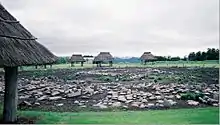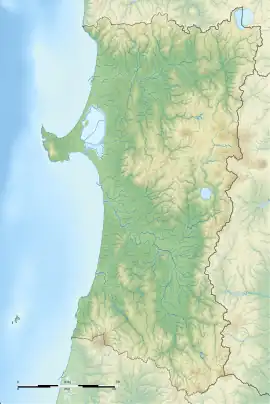大湯環状列石 | |
 Ōyu Stone Circles | |
 Ōyu Stone Circles  Ōyu Stone Circles (Japan) | |
| Location | Kazuno, Akita, Japan |
|---|---|
| Region | Tōhoku region |
| Coordinates | 40°16′18″N 140°48′14″E / 40.27167°N 140.80389°E |
| Type | stone circle |
| History | |
| Founded | 2000 BCE |
| Periods | Jōmon period |
| Site notes | |
| Public access | Yes |
The Ōyu Stone Circles (大湯環状列石, Ōyu Kanjyō Resseki) is a late Jōmon period (approx. 2,000 – 1,500 BC) archaeological site in the city of Kazuno, Akita Prefecture, in the Tōhoku region of northern Japan. The remains were designated a Special National Historic Site of Japan in 1956 by the Japanese government. The site is located approximately ten minutes by car from Towada-Minami on the JR East Hanawa Line of the Towada Interchange on the Tohoku Expressway.[1]
Description
The site consists of two large stone circles built on an artificially flattened plateau on the left bank of the Ōyu River, a tributary of the Yoneshiro River in northeastern Akita Prefecture. The site was discovered in 1931, with detailed archaeological excavations taking place in 1946 and in 1951-1952.
The larger circle, named the Manza (万座) circle, has a diameter of 46 metres and is the largest stone circle found in Japan. Several reconstructions of Jomon period dwellings have been built around the site. The slightly smaller circle, named the Nonakadō (野中堂) circle, is 42 metres in diameter and is around 90 metres away, separated from the Manza circle by Akita Prefectural Route 66. Each circle is made from rounded river stones brought from another river approximately 7 kilometres away. Each circle consists of two concentric rings separated by an open strip approximately 8 metres wide.[2] Each circle contains smaller clusters of stone, including standing stones surrounded by elongated stones in a radiating orientation, forming a sundial pointing toward the sunset on the summer solstice, and allows for calculation of the winter solstice, the vernal equinox and the sun's movements.[3]
Each circle is surrounded by the remains of buildings, storage pits and midden, and clay figurines, clayware and stoneware (including everyday pottery), stone swords and objects have been discovered. Although the form of the stone circles may have been based on the shape of circular settlements, there is no indication of permanent settlement on the site.
UNESCO listing
The site is on the UNESCO World Heritage List as one of the Jōmon Archaeological Sites in Hokkaidō, Northern Tōhoku, and other regions.[4][5]
See also
References
- ↑ "Oyu Stone Circles". Jomon Archaeological Sites in Hokkaido and Northern Tohoku. Jomon Japan. 2015. Retrieved 23 December 2015.
- ↑ Naumann, Nelly (2000). Japanese Prehistory: The Material and Spiritual Culture of the Jōmon Period. Asien-und Afrika-Studien der Humboldt-Universitat zu Berlin (Book 6). Harrassowitz Verlag. pp. 36–37. ISBN 3447043296.
- ↑ Habu, Junko (2000). Ancient Jomon of Japan. Cambridge University Press. p. 184. ISBN 0521776708.
- ↑ "Jômon Archaeological Sites in Hokkaidô, Northern Tôhoku, and other regions". UNESCO. Retrieved 19 June 2012.
- ↑ 「北海道・北東北を中心とした縄文遺跡群」の世界文化遺産登録をめざして [Towards World Heritage Inscription of "Jōmon Archaeological Sites in Hokkaidō, Northern Tōhoku, and other regions"] (in Japanese). Hokkaidō Government Board of Education. Retrieved 9 November 2013.
External links
![]() Media related to Oyu stone circles at Wikimedia Commons
Media related to Oyu stone circles at Wikimedia Commons
- 大湯環状列石 Agency for Cultural Affairs (in Japanese)
- "Excavation report" The Comprehensive Database of Archaeological Site Reports in Japan.